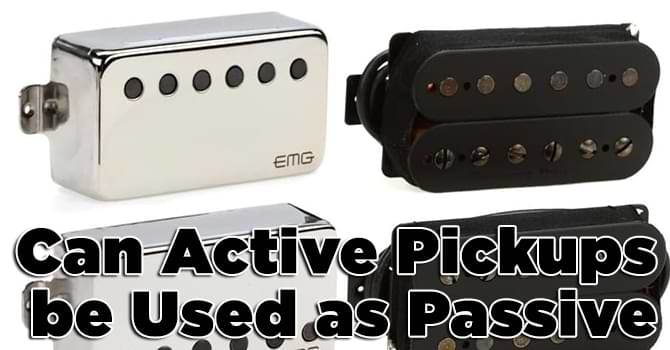Can Active Pickups be Used as Passive [Solved]
Electric guitars have evolved tremendously since their inception, with advancements in pickup technology being a significant contributor to their sonic diversity. Among the various pickup types, active pickups are renowned for their high output, clarity, and noise reduction capabilities.

However, a common question that arises is whether active pickups can be used as passive pickups. In this comprehensive guide, we will delve into the compatibility, conversion process, and potential sound implications of using active pickup as passive ones.
# Table of Contents =>
a) Understanding Active and Passive Pickups:
Active Pickups:

Active pickups utilize onboard electronics, typically powered by a battery, to boost the signal from the guitar strings. These pickups offer a higher output level and reduced noise compared to passive pickups. Common active pickup brands include EMG and Seymour Duncan Blackouts.
Passive Pickups:

Passive pickups, on the other hand, rely solely on the magnetic interaction between the strings and the pickup’s magnets to generate an electrical signal. They tend to have a more organic and dynamic response compared to active pickups. Brands like Gibson and DiMarzio are known for their passive pickups.
Comparison Table:
| Features – | Active Pickup | Passive Pickup |
|---|---|---|
| Power Source | Require a battery (e.g., 9V) for onboard electronics | Do not require a battery |
| Output Level | High output level | Moderate output level |
| Sound Characteristics | Clean, clear, and defined sound | Warm, organic, and nuanced sound |
| Tone Control | Often have onboard EQ controls | Tone controlled primarily by guitar’s circuitry |
| Noise and Interference | Designed for reduced noise | More susceptible to interference and hum |
| Dynamic Response | Less affected by guitar’s volume control | Highly responsive to guitar’s volume changes |
| Tonal Adjustability | Limited tonal versatility | Broad range of tonal possibilities |
| Magnet Types | Frequently use ceramic magnets | Can use various magnet types (Alnico, ceramic, etc.) |
| Battery Replacement | Requires periodic battery changes | No battery replacement needed |
| Installation Complexity | Involves additional wiring and electronics | Simpler wiring structure |
| Adjustments for Play Style | Ideal for high-gain and metal genres | Suited for various musical styles |
| Cost | Generally higher cost | Generally lower cost |
b) Compatibility Considerations:
Wiring Differences:
Active pickups are wired differently from passive ones due to the presence of onboard electronics. Active pickup usually require a power source, typically a 9-volt battery, which means they have extra wiring for this purpose. Passive pickups lack this additional wiring and rely solely on the magnetic coil structure.
Output Discrepancy:
Active pickups produce a stronger signal due to their onboard preamp circuitry. This higher output can cause compatibility issues if used with passive components in the guitar’s circuitry, potentially leading to unbalanced sound and tone loss.
c) Converting Active Pickups to Passive:
Replacing Electronics:

Converting active pickups to passive involves removing the onboard preamp and battery compartments. This requires replacing the active electronics with appropriate passive components, such as volume and tone pots. The wiring scheme must also be adjusted.
Magnet Consideration:
Active pickup often use ceramic magnets, while passive pickup can employ various magnet types (Alnico, ceramic, etc.). Changing the magnet type might be necessary to achieve the desired tonal characteristics after the conversion.
d) Potential Sound Implications:
Output and Dynamics:
One of the primary differences between active and passive pickup is their output level. Converting active pickup to passive can result in a decrease in output, affecting the overall tonal dynamics of the guitar. Players accustomed to the high output of active pickups might need to adjust their playing technique.
Tonal Changes:
Active pickups is famous for their clean and defined sound, while passive pickup often offer a warmer and more nuanced tone. Converting to passive pickups could alter the overall tonal profile of the guitar, requiring players to adapt to the new sound palette.
Noise and Interference:
Active pickups are designed with noise reduction in mind, which might not be the case for passive setups. Players transitioning from active to passive pickup might notice an increase in hum and interference, especially in high-gain scenarios.
e) Expert Insights and Recommendations:
Technicians:
Guitar luthiers and technicians have extensive experience with pickup conversions. The proper use of wire, soldering, and component selection is recommended to ensure a successful transition from active to passive pickup.
Player Preference:
Ultimately, the choice between active vs passive pickup depends on personal preference and musical style. While converting active pickup to passive is possible, players should carefully consider whether the tonal and technical adjustments align with their playing needs.
Conclusion:
In the realm of electric guitars, the choice between active and passive pickup is a matter of balancing tonal preferences, technical compatibility, and desired sonic characteristics. Converting active pickups to passive is feasible, but it requires careful consideration of wiring, electronics, magnets, and the potential impact on sound.
Players seeking to embark on this journey should be prepared for adjustments in output, dynamics, and tonal qualities. As technology continues to evolve, the guitar community can explore new sonic frontiers while staying rooted in the rich traditions of both active and passive pickup systems.
FAQs –
Q: Can I remove the battery and use active pickups passively?
A: Removing the battery from active pickups might result in little to no output, as the onboard preamp requires power to function. The pickups may not produce enough signal to drive an amplifier properly without the active circuitry. Converting active pickups to passive would usually involve rewiring the pickups and possibly changing other components.
Q: Are there any benefits to using active pickups as passive?
A: Converting active pickups to passive might yield a different tonal character, as passive pickups have a different magnetic design and generate a signal directly from string vibrations. However, the change in tonality might not always be desirable, and the process could potentially damage the pickups if not done correctly.
Q: Can a guitar with active pickups be modified to accommodate passive pickups?
A: Yes, it’s possible to modify a guitar with active pickups to accommodate passive pickups. But it’s a significant modification that requires rewiring, potentially changing the pickup cavities, and altering the control layout. Professional assistance is recommended for such modifications.
Last Updated on September 28, 2023 by Perry Garner


